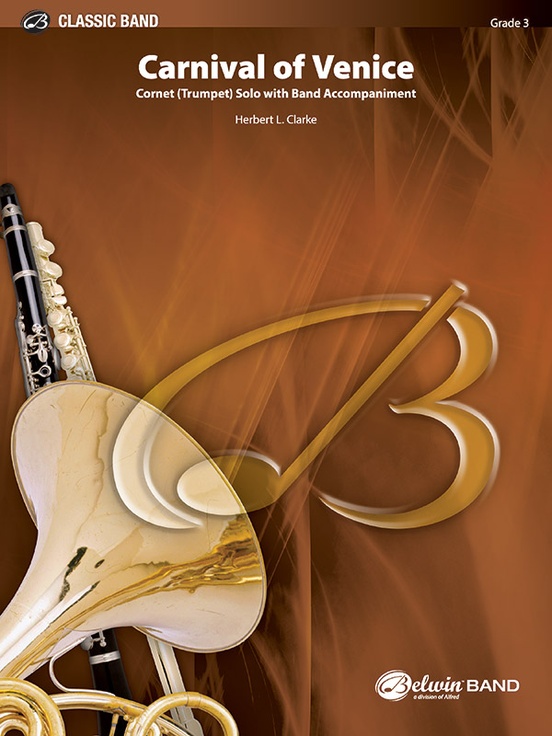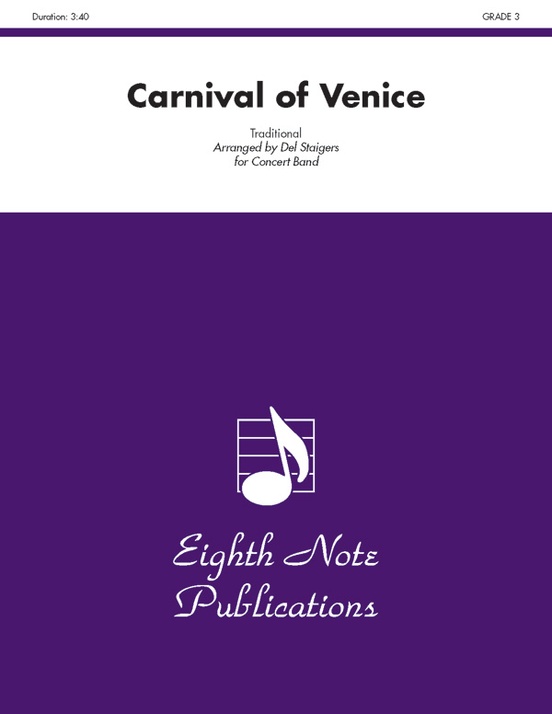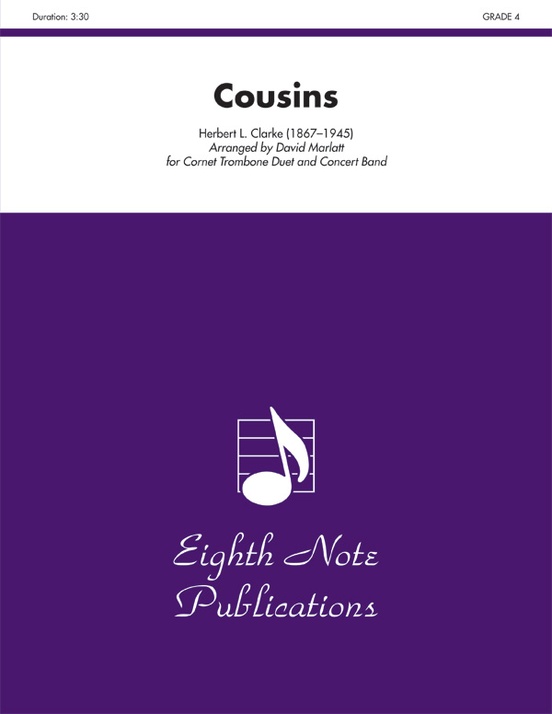Results
-
 £104.50
£104.50King Of Terror - W. Paris Chambers
William Paris Chambers (November 1, 1854 - November 13, 1913) was an American composer, cornet soloist and bandmaster who wrote several cornet solos and nearly 90 marches. His most famous marches are Chicago Tribune, The Boys of the Old Brigade, Hostrausers, Northwind and Revelation. The King of Terror March was published by J.W. Pepper in 1882. Its title is thought to be inspired by a carnival or midway attraction. The march is fast and furious, with all the drama and ferocity thats reflected in its name. Although one of his earlier marches, King of Terror contains all of the characteristics of Chambers famous bravura band writing.
Estimated dispatch 7-14 working days
-
£76.99
Columbian Fantasy (War Song) - Rogers
A brilliant "theme and variations" solo for cornet (or euphonium) by Sousa Band cornet soloist Walter Rogers. Based on the famous Civil War tune "Tramp, Tramp, Tramp." Virtuosic!
Estimated dispatch 7-14 working days
-
£71.50
The Levy Anthem - Levy
The Bb Cornet Solo part is Copyright 1912 with arrangement credited to Harry Prendiville. It is compatible with the solo cues in the 1890 Eb Cornet Conductor part arranged by Fred Lax.
Estimated dispatch 7-14 working days
-
£71.50
Flocktonian Polka - Casey
This version includes the Cornet Solo with band accompaniment.Cornet Solo with Piano accompaniment can be found under 083-1199-24.
Estimated dispatch 7-14 working days
-
£184.99
Rubicon - Bert Appermont
The Rubicon is a river in Northern Italy which Julius Caesar crossed with his army in 49 BC in defiance of the leaders of Rome, who feared his power. A civil war against rival Pompey ensued, which culminated in Caesar seizing power as the absoluteruler of Rome. The phrase "crossing the Rubicon" therefore refers to any person committing himself irrevocably to a risky, decisive and irrevocable of course of action.The work consists of three parts that deal with this important moment in history.Part 1 (Meditation) symbolises Caesars request to the Gods to assist him in his difficult choice. In a slow introduction we hear the melancholy and beseeching sounds of the duduk (alternatively, this part can be played by a soprano saxophone)and of the soprano solo singer over the bourdon accompaniment. The soprano solo singer then sings "dona tibi pacem" (give him rest) in a melodious and probing theme.In Part 2 (Battle of Pharsalus) trumpets and trombones resound alternately ina stately Roman fanfare, producing a stereophonic effect. This develops into a martial theme in which Caesars impressive army goes to battle against the army of rival Pompey. While the theme of Caesars army fades away, Pompeys theme emerges as anaive dance in six-eight time. His army is definitely in the majority and it believes it can easily defeat the enemy. Suddenly trumpets and trombones clash on two sides of the orchestra: Caesars army advances and attacks. A fierce battle ensues inwhich the two themes are played alternately as well as simultaneously. Thanks to his shrewd battle tactics, Caesar manages to win this legendary battle after all: his theme resounds ever louder in trumpets and horns until everything dies out andchanges into a kind of reconciliation between the soldiers of the two armies. The melancholy "dona tibi pacem" from part 1 now serves as a reconciliation theme.Caesar is now the sole ruler of the New Roman Empire, which would be destined to leave itsmark on our Western civilisation to this day. The third part is a sparkling succession of dance music (Dance) with many Greek and Roman elements in which Caesars victory is praised and celebrated. It is common knowledge that the culture(arts, gods, etc.) of the Romans drew heavily on Greek culture. I have therefore used an authentic Greek theme (the Seikolos song) several times in this part (bar 17 in the euphonium, bar 60 in the base section, bar 68 in the sopranosaxophone) to suggest the music of that era and to evoke the right atmosphere. After a gradual increase in tempo in the entire orchestra, the opening melody gloriously resounds once more, surrounded by virtuoso dance music. The work ends withbombastic brass fanfares in which Caesars theme triumphs once more.NOTE FOR THE CONDUCTOR:The Armenian duduk and the monochord that are used in the introduction give a special tone to the music, but could be substituted (soprano saxophone instead ofthe duduk) or left out (monochord). The soprano solo is also doubled within the orchestra and could therefore also be left out if necessary, although it does provide the work with an extra dimension. The male voices in the introduction and the finalecould possibly be replaced with a synthesizer with choral setting.As a visual and acoustic element in part 2, the trumpets, the e-flat cornet, the small drum and trombones can be stood up and placed at two sides of the orchestra (bar 80).Seen fromthe point of view of the conductor, put the trumpets, the e-flat cornet and the small drum in the left section and the trombones in the right section of the orchestra. This also helps to create a visual contrast between the two themes of the secondpart. The players can be seated again at bar 97 or bar 121. The soprano soloist can be placed in or in front of the orchestra, depending on what gives the best result. For the conclusion of the work the soprano solo can be sung from afar (from thewings) to create additional atmosphere.This work was composed especially for the "St Joseph" brass band from Pey/Echt (Belgium) with conductor Mark Prils.
Estimated dispatch 7-14 working days
-
 £140.50
£140.50Molly On The Shore - Percy Aldridge Grainger
No. 23 offerainger's British Folk Music settings, Molly on the Shore is a rollicking treatment of a popular Irish Reel. It scampers and bounces its way through a succession of sonorous climaxes, accumulating an amazing collection of memorable counter themes as it goes along, before subsiding in a delicately scored coda that ends with a characteristic Grainger bang. An acclaimed classic, we are proud to offer this engraved and corrected edition of Molly on the Shore with a complete full score. Duration: 4' Key: Ab Ranges: Solo Cornet - C, Cornet - G, Horn - Ab, Trombone - Ab
Estimated dispatch 7-14 working days
-
 £214.95
£214.95Christmas Collection - Wind Band Set - March Card Size
The wind band set contains 30 march card size parts: Flute 1 x2Flute 2 x2Oboe x1Bassoon x1Clarinet 1 Bb x2Clarinet 2 Bb x2Soprano Saxophone Bb x1Alto Saxophone 1 Eb x1Alto Saxophone 2 Eb x1Tenor Saxophone Bb x1Baritone Saxophone Eb x1Horn 1 in F x1Horn 2 in F x1Solo & 1st Cornet Bb x22nd Cornet Bb x2Trombone 1 B.C. x1Trombone 2 B.C. x1Bass Trombone x1Euphonium B.C. x1Euphonium Bb T.C. x1Tuba B.C. x2String Bass x1Percussion x1 Titles:A child this day is bornA Christmas lullabyA great and mighty wonderAll I want for Christmas is youAll my heart this night rejoicesAngels, from the realms of Glory (Come and worship)Angels, from the realms of Glory (Iris)Angels we have heard on highA starry nightAs with gladness men of oldAuld lang syneA virgin most pureAway in a manger (The manger scene)Away in a manger (Traditional)A winter's taleBethlehemBrightest and best (Spean)Brightest and best (Traditional)Calypso CarolCarol for the NativityCarol of the bellsCarol of the drumChild of MaryChristians Awake!Christ is born (Il est n)Christ was born on Christmas DayCome and join the celebrationCome, children, come quicklyCoventry CarolDeck the hallDing dong! merrily on highDo you hear what I hear?Frosty the snowmanGabriel's MessageGaudeteGlory in the highestGlory in the highest HeavenGod of God, the uncreatedGod rest you merry, gentlemenGood Christian men, rejoiceGood King WenceslasGo, tell it on the mountain!Happy Christmas (War is over)Hark the glad sound!Hark! the herald angels singHave yourself a merry little ChristmasHere we come a-wassailingHow far is it to Bethlehem?Huron CarolInfant HolyIn the bleak midwinter (Cranham)In the bleak midwinter (Darke)I saw mommy kissing Santa ClausI saw three ships come sailing inIt came upon a midnight clear (Traditional)It came upon a midnight clear (Willis)It's beginning to look a lot like ChristmasIt's the most wonderful time of the yearI wish it could be Christmas everydayI wonder as I wanderJesus, good above all otherJingle BellsJingle bell rockJoy to the world!Last ChristmasLet it snow!Little baby JesusLittle children, wake and listenLittle DonkeyLittle Jesus, sweetly sleepLo! he comes with clouds descendingLong, long agoLove came down at ChristmasMary's boy childMary's ChildMasters in this hallMerry Christmas everyoneMistletoe and wineNoelO Christmas treeO come, all ye faithfulO come, ImmanuelO Heaven-sent KingO holy night!O little town of Bethlehem (Christmas Carol)O little town of Bethlehem (Forest Green)O little town of Bethlehem (St Louis)Once in royal David's cityPast three o'clockPatapanPersonent HodiePraise ye the LordRing the bellsRise up, shepherd!Rockin' around the Christmas treeRudolph, the red-nosed reindeerSans day carolSanta Claus is comin' to townSaviour's DaySee, amid the winter's snowSilent Night!Sleigh RideSoftly the night is sleepingSo here it is, merry ChristmasStars are shiningStill, still, stillStop the cavalrySussex CarolSweet chiming bellsSweet chiming Christmas bellsThe candle songThe cherry tree carolThe Christmas songThe first NowellThe holly and the ivyThe infant KingThe light has comeThe shepherds' farewellThe stable doorThe star in the eastThe twelve days of ChristmasThe virgin Mary had a baby boyThey all were looking for a kingThou didst leave thy throneThree kings' marchUnto us a boy is bornWalking in the airWe gather round the manger-bedWe three kings of Orient areWe wish you a merry ChristmasWhat child is this?When a child is bornWhen Santa got stuck up the chimneyWhence is that goodly fragrance flowing?When wise men came seekingWhile shepherds watched (Cranbrook)While shepherds watched (Handel)While shepherds watched (Winchester Old)White ChristmasWho is he?Winter WonderlandWorldwide Christmas messageZither CarolA starry nightChristmas JoyChristmas PraiseCoventry CarolInfant HolyMid-winterRudolph, the red-nosed reindeerThe everlasting lightTo celebrate his birthYuletide Rag
Estimated dispatch 7-14 working days
-
 £76.95
£76.95Carnival of Venice - Herbert L. Clarke
This dazzling cornet/trumpet virtuoso piece was based on an air by Niccolo Paganini, and was originally composed for violin. Herbert L. Clarke was called the greatest cornetist of all time, and at the urging of another famous cornet soloist, Walter Rogers, Clarke was encouraged to write his own solos. His composition legacy includes over fifty solos, duets, and trios, as well as marches and works for concert band. may well be his best-known piece, and generations of brass players have worked to conquer and perform this masterwork.
Estimated dispatch 3-5 working days
-
 £62.95
£62.95Carnival of Venice
The musical form theme and variations became popular as a cornet showpiece in the early 1900s. Simple themes or popular folk songs from a variety of cultures were used. The lyrical theme would be played, then a series of variations followed demonstrating the technical skill and virtuosity of the player. Often triple tonguing and/or range extremes were used as showoff devices. The most famous of these cornet theme and variations is the .
Estimated dispatch 3-5 working days
-
 £62.95
£62.95Cousins - Herbert L. Clarke / arr. David Marlatt
Clarke wrote Cousins, a cornet and trombone duet with band accompaniment in 1904 for himself as the cornet soloist and Leo Zimmerman as the trombone soloist. To create a clean new edition, dynamics and articulations were made more consistent in the parts. Other items were changed to reflect the bands of today including F Horn parts rather than E-flat and the percussion parts have been reorganized. This is the first time this work has been available with a full conductor score rather than a piano reduction.
Estimated dispatch 3-5 working days
